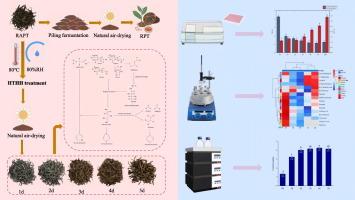High temperature and high humidity (HTHH) alter flavor properties of Pu-erh tea associated with burnt aroma emergence
IF 8
1区 农林科学
Q1 FOOD SCIENCE & TECHNOLOGY
引用次数: 0
Abstract
The high-temperature and high-humidity (HTHH, 80 °C, 80 % relative humidity) environment has altered the characteristics and flavor of raw Pu-erh tea after 5 days of treatment. The results showed that the colors gradually deepened during the treatment process in five days. Based on sensory evaluation, the roasted aroma and woody aroma of Pu-erh tea were increased with the increase of treatment time. According to the results of gas chromatography–mass spectrometry, the results revealed gradual decrease in floral and fruity aroma compounds, such as (+)-dipentene and linalool. The concentrations of 5-methyl-2-furancarboxaldehyde (caramel) and tea pyrrole (burnt) increased progressively. (E)-2-Octenal, 1-octen-3-one, and 1-octen-3-ol were the key compounds responsible for the mushroom aromas. These compounds contributed to a flavor profile that was comparable to that of ripe Pu-erh tea. Safranal and guaiacol, also identified as key flavor compounds, exhibited herbal and burnt aromas. Subsequently, the reaction mechanism under HTHH conditions was elucidated. This study provides significant data reference guidance in production development of Pu-erh tea.

高温高湿会改变普洱茶的风味特性,使其产生焦香味
高温高湿(HTHH, 80℃,80%相对湿度)环境处理5天后,普洱茶原料的特性和风味发生变化。结果表明,在5天的处理过程中,颜色逐渐加深。感官评价结果表明,随着处理时间的延长,普洱茶的烘烤香气和木香有所增加。气相色谱-质谱联用分析结果显示,花香和果香化合物(+)-二戊烯和芳樟醇逐渐减少。5-甲基-2-糠醛(焦糖)和茶吡咯(焦糖)的浓度逐渐升高。(E)-2-辛醛、1-辛-3- 1和1-辛-3-醇是产生香菇香气的主要化合物。这些化合物形成了一种与成熟的普洱茶相当的风味。藏红花醛和愈创木酚也被认为是关键的风味化合物,表现出草药和烧焦的香气。随后,阐明了HTHH条件下的反应机理。本研究为普洱茶的生产开发提供了重要的数据参考指导。
本文章由计算机程序翻译,如有差异,请以英文原文为准。
求助全文
约1分钟内获得全文
求助全文
来源期刊

Food Research International
工程技术-食品科技
CiteScore
12.50
自引率
7.40%
发文量
1183
审稿时长
79 days
期刊介绍:
Food Research International serves as a rapid dissemination platform for significant and impactful research in food science, technology, engineering, and nutrition. The journal focuses on publishing novel, high-quality, and high-impact review papers, original research papers, and letters to the editors across various disciplines in the science and technology of food. Additionally, it follows a policy of publishing special issues on topical and emergent subjects in food research or related areas. Selected, peer-reviewed papers from scientific meetings, workshops, and conferences on the science, technology, and engineering of foods are also featured in special issues.
 求助内容:
求助内容: 应助结果提醒方式:
应助结果提醒方式:


